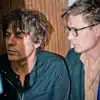


ORIGIN
Düsseldorf, Germany
About Mouse on Mars
Crafting complex, heavily hybridized forms of everything from ambient, techno, and dub to rock, jazz, and jungle, Germany's Mouse on Mars is the duo of Andi Toma and Jan St. Werner (who also recorded as half of the duo Microstoria with Oval's Markus Popp and solo as Lithops). Toma and St. Werner's flair for combining and recontextualizing sounds and genres only grew richer over the years: On early albums such as 1994's Vulvaland and the following year's Autoditacker, they forged an unpredictable, beguiling mix of ambient pop, dub, Krautrock, industrial and more. The duo added harder-edged beats and more hooks to 2000's Idiology, while 2012's wide-ranging Parastrophics found the pair just as committed to trying anything. At the close of the 2010s, albums like 2018's Dimensional People, which melded footwork and orchestral influences with triggered percussion, proved St. Werner and Toma's blend of cutting-edge technology, academic theory, and enduring love for all kinds of dance music was as resilient and relevant as ever.nn Toma and St. Werner began working as Mouse on Mars in 1993 and fused an admiration for the early experiments of Krautrock outfits like Can, Neu!, Kluster, and Kraftwerk with influences from the burgeoning German techno and ambient scenes. A demo of material found its way to London-based guitar-ambient group Seefeel, who passed it on to the offices of their label, Too Pure.nn The duo's first single, "Frosch," was released by the label soon after and was also included on their debut album, Vulvaland. Immediately hailed for its beguiling, inventive edge that seemed to resist all efforts at easy "schublade" (an even less flattering approximation of the English "pigeonhole"), Vulvaland was reissued in 1995 by (oddly) Rick Rubin's American Recordings label, which also released their more varied and upbeat follow-up, Iaora Tahiti, soon after. They returned in 1997 with three different releases -- the EP Cache Coeur Naif, the LP Autoditacker, and the vinyl-only Instrumentals. Another vinyl release, Glam, appeared in 1998, and was followed a year later by the official follow-up to Autoditacker, Niun Niggung, which featured more live instrumentation. Around this time, Mouse on Mars appeared on several compilations of experimental electronic music, including Volume's popular Trance Europe Express series, and they were also prominently featured on the tribute album Folds and Rhizomes for Gilles Deleuze.nn Mouse on Mars began the 2000s with two of their most accessible albums: 2000's Idiology, which introduced percussionist/collaborator Dodo NKishi into the fold, and 2004's Radical Connector, which spawned a world tour captured by the following year's concert album Live04. The hard-hitting Varcharz, which was recorded at the same time as Radical Connector, was released by Ipecac in 2006. Following Varcharz, the duo kept busy with other projects, both collaborative and solo, including their work with Mark E. Smith as Von Südenfed, St. Werner's duties as the artistic director of Amsterdam's Institute for Electronic Music, and Toma's productions for Stereolab, Junior Boys, and Moondog.nn The pair reconvened as Mouse on Mars for 2011's Paeanumnion, an electronically processed live orchestral piece for which they created their own music software. This software was also crucial in crafting 2012's Parastrophics, which returned to the textural interplay and mischievous avant electropop for which the duo were acclaimed. Later that year, they returned with WOW, a mini-album inspired by club music and acid techno that featured collaborations with vocalist Dao Anh Khanh and the punk band Las Kellies. The duo celebrated their 21st anniversary in 2014 with 21 Again, which featured collaborations with friends such as Tortoise, Mark E. Smith, Laetitia Sadier, Siriusmo, and Modeselektor. They commemorated the album's release with a two-day music festival in Berlin.nn Mouse on Mars returned with new music in 2016 with the Infinite Greyscale release Lichter, a 13-minute track that marked the start of a series of electro-acoustic dub compositions from the duo. Along with live percussion by NKishi, the track also featured contributions by MIDI robot triggers (live performances of Lichter also included flashing lights triggered by data from the track's sounds and rhythms). Arriving in 2017, Synaptics EP saw them embrace their love of juke, footwork, and chopped-up house music. During this time, St. Werner was also a visiting lecturer at MIT's Art, Culture and Technology program as well as a professor of interactive media and dynamic acoustics at the Academy of Fine Arts Nuremberg. For 2018's full-length Dimensional People, Mouse on Mars combined triggered percussion with footwork and orchestral influences and collaborated with artists including Bon Iver's Justin Vernon, the National's Aaron and Bryce Dessner, Beirut's Zach Condon, Spank Rock, Ensemble Musikfabrik, and Swamp Dogg. ~ Sean Cooper
Mouse on Mars discography
26 discs

Dimensional People
2018

Synaptics - Single
2017

Lichter - EP
2016
See all discs
The most viewed
Mouse on Mars songs in January
Top Artists
About us
• What is CANCIONEROS.COM/LYRICS
• Contact us
• How to collaborate
Notes


